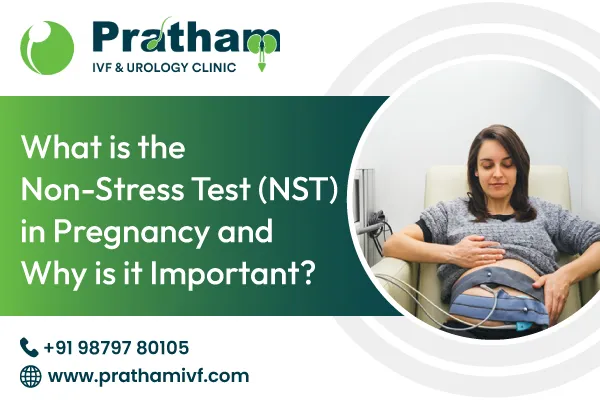
To protect both mother and baby, modern prenatal care combines frequent checks, screening tests, and specialized monitoring. From measuring blood pressure and weight to tracking the baby’s movements and growth, each visit gives your care team a clearer picture of how the pregnancy is progressing. When a closer look at the baby’s well-being is needed—especially in the third trimester—your provider may recommend a Non-Stress Test (NST).
An NST is a simple, painless test that listens to your baby’s heartbeat and watches how it changes with movement. Healthy babies naturally experience brief heart-rate rises (accelerations) when they wiggle or kick. The NST records those patterns to reassure your team that the baby is well-oxygenated and not in distress.
Importance of Understanding NST for Expectant Mothers
Knowing what the NST does—and what it doesn’t—reduces anxiety, helps you prepare for appointments, and empowers you to participate in decision-making. You’ll understand why the test is suggested, what to expect during the session, and how results guide next steps.
The NST measures fetal heart rate (FHR) over time and looks for accelerations—brief increases in the baby’s heart rate associated with movement. These accelerations are a sign of adequate oxygen and a responsive nervous system. The test is called “non-stress” because it does not require contractions or stressors to evaluate the baby; it simply observes the natural pattern while the uterus is at rest.
Procedure Involved in Conducting an NST
Two soft belts are placed around your abdomen. One holds a Doppler ultrasound sensor that detects the baby’s heartbeat; the other holds a tocotransducer that can detect tightening of the uterus. You may receive a button to press whenever you feel movement. The test typically lasts 20–30 minutes, although it can be extended if the baby is resting.
Purpose of the Non-Stress Test
- Assessing fetal well-being: The main goal is to confirm that the baby is receiving enough oxygen through the placenta. A reactive pattern (normal accelerations) reassures your team that the baby is doing well at that moment.
- Monitoring fetal heart rate patterns: The NST looks for specific heart-rate changes—baseline rate, variability (the subtle beat-to-beat changes), and accelerations. Good variability and appropriate accelerations are signs of a healthy autonomic nervous system and adequate oxygenation.
- Identifying potential complications: If the NST is non-reactive (doesn’t show expected accelerations), it may indicate that the baby is asleep, the timing is too early, or—less commonly—that hypoxia (low oxygen) or other issues need further assessment. A non-reactive result prompts additional testing rather than immediate conclusions.
When is the NST Performed?
A Non-Stress Test (NST) is most commonly performed during the third trimester of pregnancy, usually after 32 weeks, when consistent accelerations in the baby’s heart rate are expected. In certain cases, your healthcare provider may recommend performing the NST slightly earlier, depending on your health and pregnancy condition. Doctors often advise an NST if there are concerns about decreased fetal movements or when the mother has medical conditions such as diabetes, high blood pressure, or preeclampsia that could affect the baby. It is also recommended in post-term pregnancies, especially if the due date has passed, or in multiple gestations like twins or triplets, where monitoring is crucial. Additional reasons include suspected fetal growth restrictions, abnormal amniotic fluid levels, or placental issues. If you have experienced complications in a previous pregnancy or are on medications that require close monitoring, your provider may also recommend an NST to ensure your baby’s wellness. In higher-risk cases, NSTs may be performed once or twice weekly. The schedule is individualized based on maternal and fetal factors and may change as pregnancy progresses.
How is the NST Conducted?
You’ll be seated or lying on your side in a quiet room. Dim lights, a comfortable position, and a light snack beforehand can help encourage fetal activity. You can usually use the restroom first to reduce discomfort.
Equipment Used During the Test
- Doppler Ultrasound Transducer: A handheld device that records the baby’s heartbeat using sound waves, helping doctors assess fetal well-being and heart rate patterns accurately.
- Tocotransducer: This device is placed on the mother’s abdomen to sense uterine contractions and activity, providing crucial information about the baby’s response.
- Elastic Belts: Soft, adjustable belts secure the sensors in place on the mother’s abdomen, ensuring proper positioning throughout the duration of the test.
- Fetal Monitor: The monitor either prints or digitally stores tracings of the baby’s heart rate along with uterine activity for clear medical review and documentation.
- Event Marker Button: If provided, the mother presses this button whenever she feels fetal movement, allowing synchronization of heart rate changes with activity.
Step-by-Step Process of the NST
- Positioning: You’re made comfortable on your side or semi-reclined.
- Sensor placement: Two sensors are positioned and secured with belts.
- Baseline recording: The baby’s baseline heart rate and variability are recorded.
- Movement phase: You may press a button with movements; staff may gently reposition sensors if needed.
- Observation window: Typically 20 minutes; extended if baby is resting or data is unclear.
- Completion: Sensors are removed; your provider reviews the tracing and discusses results.
Understanding Reactive vs. Non-Reactive Results
- Reactive NST: Shows expected accelerations—usually at least two accelerations of the fetal heart rate within 20 minutes, each rising by a set number of beats per minute and lasting a set duration (criteria vary by gestational age).
- Non-reactive NST: Does not meet criteria within the testing window. This may be due to fetal sleep cycles, maternal medications, earlier gestational age, or, less commonly, a baby not tolerating the environment well.
Implications of Different Outcomes
- Reactive: Reassuring snapshot that the baby is well-oxygenated now.
- Non-reactive: Not a diagnosis. It prompts further evaluation such as vibroacoustic stimulation, extended monitoring, a biophysical profile (BPP), or a contraction stress test (CST), depending on the clinical picture.
Follow-Up Actions Based on Results
Your provider integrates NST findings with your history, physical exam, and other tests. Depending on results, plans range from routine follow-up to additional monitoring the same day, or—rarely—discussions about the timing of delivery.
Benefits of the Non-Stress Test
- Early detection of fetal distress: The NST can reveal patterns suggesting a baby may not be getting optimal oxygenation. Early recognition allows timely intervention—additional testing, closer follow-up, or delivery when needed.
- Peace of mind for expectant parents: Seeing normal patterns and hearing a strong heartbeat often reduces anxiety, especially in high-risk pregnancies or when movements feel different.
- Contribution to overall prenatal care: NSTs complement ultrasounds, growth assessments, and clinical exams, giving a real-time view of fetal status that can change management thoughtfully and safely.
Risks and Limitations of the NST
Like any screening tool, NSTs can be non-reactive even when the baby is fine (for example, sleeping), or occasionally appear reactive when other issues exist. That’s why providers interpret NSTs alongside the full clinical picture. In early gestation or when maternal medications (like certain beta-blockers or sedatives) affect fetal reactivity, an NST might be less informative. Quiet babies or sensor misplacement can also limit clarity. An NST is a snapshot, not a stand-alone diagnosis. Combining results with biophysical profile (BPP), Doppler studies, growth ultrasounds, and maternal assessments ensures balanced, evidence-based decisions.
Alternatives to the Non-Stress Test
Other Fetal Monitoring Techniques
Apart from the Non-Stress Test (NST), several other techniques are used to assess a baby’s health during pregnancy. A Biophysical Profile (BPP) combines ultrasound scoring of fetal breathing, movement, tone, and amniotic fluid with an NST, though modified versions may exclude the NST. The Contraction Stress Test (CST) evaluates how the baby’s heart responds to mild contractions, ensuring the placenta can support fetal needs during labor. Doppler velocimetry is another method, using ultrasound to study blood flow in the umbilical artery and other vessels, which is crucial for detecting growth restrictions or placental issues. Finally, kick counts, performed at home by the mother, involve tracking fetal movements to monitor activity and provide reassurance about the baby’s well-being. These tests collectively enhance pregnancy care by ensuring timely interventions when needed.
Comparison of NST with Alternative Methods
- NST: Quick, non-invasive, real-time heart rate assessment; no imaging.
- BPP: Broader physiologic assessment; takes longer, requires ultrasound.
- CST: Useful in select cases; not routine due to induced contractions.
- Dopplers: Insight into placental function; often used in growth restriction or preeclampsia.
When to Consider Alternatives
If an NST is non-reactive or equivocal, or if specific concerns (growth restriction, fluid levels) exist, your provider may choose BPP, Doppler studies, or additional ultrasound to gain more information.
Common Myths About NSTs
Myth: “NSTs are stressful for the baby.”
Fact: The test is observational; no electric current reaches the baby.
Myth: “A non-reactive NST means something is wrong.”
Fact: It’s a cue for more assessment, not a diagnosis.
Myth: “NSTs always predict labor timing.”
Fact: They evaluate current well-being, not due dates.
Importance of Discussing Ultrasound and NST Needs
Every pregnancy is different, so personalized monitoring is essential. Sharing symptoms like decreased movements, medical history, and personal preferences with your healthcare provider ensures the right balance of routine, enhanced, or high-risk monitoring. Discussing ultrasound and Non-Stress Test (NST) needs helps identify the safest care plan, improves maternal confidence, and supports the best outcomes for both mother and baby throughout pregnancy.
Why Choose Pratham IVF Center?
At Pratham IVF Center, every expectant mother receives personalized care supported by modern technology and a compassionate approach. We understand that pregnancy is a unique journey, and our goal is to provide reassurance, guidance, and safe outcomes at every stage. One of the most effective tools we use is the Non-Stress Test (NST), which monitors your baby’s heart rate and movements to ensure healthy development. This non-invasive test offers real-time insights into fetal well-being, helping doctors detect concerns early and take the right steps. Combined with regular ultrasounds and comprehensive prenatal checkups, NST forms a vital part of our care plan.
As the best IVF center in Ahmedabad and recognized as the best IVF clinic in Ahmedabad, we go beyond advanced treatments by offering emotional support and continuous monitoring. Our highly experienced team is dedicated to making every mother feel confident and secure throughout her pregnancy. If you have questions about the NST, are experiencing concerns, or wish to learn more about pregnancy monitoring, connect with us today. For trusted advice or to schedule a consultation, contact Pratham IVF Center, Ahmedabad. We are here to guide you toward a safe, healthy, and fulfilling pregnancy journey.
Conclusion
The Non-Stress Test is a quick, pain-free way to check how your baby is doing—especially in the third trimester or when risk factors are present. By tracking heart-rate changes with movement, the NST provides real-time reassurance or an early alert for further evaluation. If your provider suggests an NST, ask questions, learn what the results mean, and how they guide care. If you’re worried about movements or have risk factors, an NST may be an appropriate next step.
Contact us for more info – Call: +91 98797 80105, mail: prathamivf@gmail.com. For compassionate, personalized prenatal guidance you can trust, choose Pratham IVF Center.
 Ahmedabad Top Rated IVF Center
Ahmedabad Top Rated IVF Center




